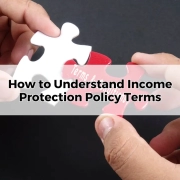How to Calculate Your Income Protection Needs
Table of Contents
ToggleIntroduction to Income Protection
Understanding Income Protection Insurance
Income protection insurance is a crucial safeguard for your financial well-being. It provides a safety net, ensuring that if you’re unable to work due to illness or injury, you still receive a portion of your income. This type of insurance helps maintain your standard of living and supports your financial commitments during periods of incapacity.
Importance of Income Protection
The significance of income protection cannot be overstated. Without it, a sudden loss of income can lead to financial distress, forcing you to dip into savings or accumulate debt. Income protection offers peace of mind, knowing that your financial stability is preserved even when you’re unable to earn a paycheck.
Evaluating Your Current Financial Situation
Assessing Your Income and Expenses
Start by evaluating your current financial situation. This involves a thorough review of your income and expenses. Calculate your monthly take-home pay and list all regular expenses, including mortgage or rent, utilities, groceries, and other living costs. Understanding this baseline is essential for determining your coverage needs.
Identifying Financial Obligations
In addition to everyday expenses, consider your financial obligations. These may include loan repayments, credit card debt, and any other recurring financial commitments. Accurately identifying these obligations ensures that your income protection policy covers all necessary expenses.
Determining the Coverage Amount
Calculating Your Monthly Income Replacement
To determine the appropriate coverage amount, calculate how much of your income you need to replace. Most income protection policies cover up to 75% of your pre-tax income. This replacement ratio helps ensure that you can meet your financial commitments without significant lifestyle changes.
Factoring in Additional Expenses
Beyond regular expenses, factor in additional costs that may arise during your period of incapacity. These could include medical expenses, rehabilitation costs, or modifications to your home if required. Comprehensive coverage should account for these potential additional expenses.
Considering Your Employment Benefits
Employer-Provided Income Protection
Check if your employer offers income protection as part of your benefits package. Employer-provided coverage can be a valuable addition but may have limitations in terms of coverage amount and benefit period. Understanding these details helps in deciding if additional coverage is necessary.
Sick Leave and Other Benefits
Consider other employment benefits such as sick leave and long service leave. These benefits can provide short-term financial support but may not be sufficient for long-term incapacity. Assessing these benefits helps in determining the gap that your income protection policy needs to fill.
Understanding Policy Options
Types of Income Protection Policies
Income protection policies come in various forms. Some offer agreed value policies, where the benefit amount is agreed upon at the time of purchase, while others offer indemnity policies, which pay a benefit based on your income at the time of the claim. Understanding these types helps in choosing the right policy for your needs.
Key Features to Look For
When selecting a policy, look for key features such as benefit period, waiting period, and premium structure. Additionally, consider any optional add-ons or riders that can enhance your coverage, such as rehabilitation benefits or coverage for specific illnesses.
Policy Waiting Periods
Definition of Waiting Period
The waiting period is the time you must wait after becoming unable to work before your income protection benefits commence. Common waiting periods range from 14 days to two years. Choosing the right waiting period balances affordability with your financial resilience.
Choosing the Right Waiting Period
Shorter waiting periods provide quicker access to benefits but come with higher premiums. Conversely, longer waiting periods reduce premiums but require you to rely on savings or other resources initially. Assess your financial buffer to choose an appropriate waiting period.
Policy Benefit Periods
Definition of Benefit Period
The benefit period is the length of time your income protection payments will continue while you remain unable to work. Benefit periods can range from two years to up to age 65. Selecting the right benefit period ensures ongoing financial support.
Selecting an Appropriate Benefit Period
Consider factors such as your age, financial obligations, and career plans when choosing a benefit period. Longer benefit periods provide extended security but at a higher cost. Balance your need for long-term coverage with affordability.
Factors Affecting Premiums
Age and Health
Your age and health significantly impact your insurance premiums. Younger, healthier individuals typically pay lower premiums. Maintaining a healthy lifestyle can help manage these costs and improve your insurability.
Occupation and Lifestyle
Your occupation and lifestyle also influence premiums. High-risk occupations or hobbies can result in higher premiums due to the increased likelihood of claims. Understanding these factors helps in anticipating and managing premium costs.
Tax Implications of Income Protection
Tax Deductibility of Premiums
One of the advantages of income protection insurance is the tax deductibility of premiums. Premiums paid for income protection policies are generally tax-deductible, reducing your overall tax liability.
Taxation of Benefits
While premiums are tax-deductible, it’s important to note that the benefits received from an income protection policy are considered taxable income. Planning for this tax impact ensures you maintain adequate post-tax income during your benefit period.
Adjusting Coverage Over Time
Reviewing Your Policy Regularly
Regularly review your income protection policy to ensure it continues to meet your needs. Life changes such as a new job, salary increase, or change in financial obligations may necessitate adjustments to your coverage.
Adapting to Life Changes
As your life evolves, so should your income protection strategy. Ensure your policy adapts to significant life events, providing continued financial security. Regular reviews and updates keep your coverage aligned with your current circumstances.
Working with a Financial Adviser
Benefits of Professional Guidance
Engaging a financial adviser provides expert guidance in navigating the complexities of income protection insurance. Advisers can help tailor a policy to your specific needs, ensuring comprehensive coverage.
Finding a Qualified Adviser
Choose a financial adviser with experience in insurance and financial planning. Look for credentials, reviews, and a proven track record. A qualified adviser can offer invaluable insights and support in securing the right income protection policy.
Conclusion
Calculating your income protection needs involves evaluating your financial situation, understanding policy options, and considering various personal factors. Comprehensive coverage ensures financial stability during periods of incapacity.
Stay proactive in managing your income protection strategy. Regular reviews, professional advice, and a thorough understanding of your needs help secure adequate coverage, providing peace of mind and financial security for you and your loved ones.









